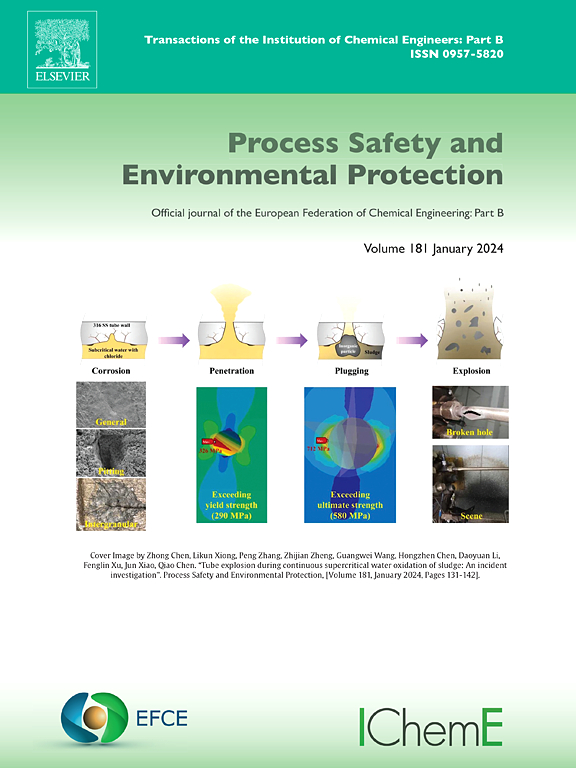Energy, exergy, exergoeconomic, exergoenvironmental (4E) analysis and optimization of three CCHP systems with CO2 capture using LNG cold energy and flue gas waste heat
IF 6.9
2区 环境科学与生态学
Q1 ENGINEERING, CHEMICAL
引用次数: 0
Abstract
To fully utilize the flue gas waste heat and liquefied natural gas (LNG) cold energy, three combined cooling, heating, and power (CCHP) systems integrating organic Rankine cycle (ORC), organic flash cycle (OFC), and CO2 capture (CCS) with different structures are proposed in this paper. The proposed systems are subjected to multi-objective optimization using genetic algorithm (NSGA-II) and modified particle swarm optimization (MOPSO), respectively, to find the optimal operating conditions of the systems. The optimization results show that the CCHP system with a three-stage organic Rankine cycle has the best performance, and the multi-objective optimization results are the exergy efficiency, product unit cost, product unit environmental impact, and CO2 capture rate of 83.75 %, 29.13 $/GJ, 22.53 mPts/GJ, and 94.43 % respectively. In addition, energy, exergy, exergoeconomic, and exergoenvironmental (4E) analyses were performed to analyze the system performance under optimal operating conditions. The analysis results show that HX9 has the highest exergy destruction, which affects the system's economic performance and environmental impact. In summary, the proposed system can realize effective cogeneration of cold, heat and power, and complementary utilization of LNG cold energy and flue gas waste heat.
利用LNG冷能和烟气余热捕集CO2的三个CCHP系统的能源、火用、经济、环境(4E)分析与优化
为了充分利用烟气余热和液化天然气(LNG)冷能,本文提出了有机朗肯循环(ORC)、有机闪蒸循环(OFC)和CO2捕集(CCS)三种不同结构的冷热电联产(CCHP)系统。分别采用遗传算法(NSGA-II)和改进粒子群算法(MOPSO)对系统进行多目标优化,找到系统的最优运行状态。优化结果表明,三级有机朗肯循环的热电联产系统性能最佳,多目标优化结果为:火用效率为83.75 %,产品单位成本为29.13美元/GJ,产品单位环境影响为22.53 mPts/GJ, CO2捕集率为94.43 %。此外,还进行了能源、火用、火用经济和火用环境(4E)分析,以分析系统在最佳运行条件下的性能。分析结果表明,HX9的火用破坏最大,影响了系统的经济性能和环境影响。综上所述,本系统可实现冷、热、电的有效热电联产,LNG冷能与烟气余热的互补利用。
本文章由计算机程序翻译,如有差异,请以英文原文为准。
求助全文
约1分钟内获得全文
求助全文
来源期刊

Process Safety and Environmental Protection
环境科学-工程:化工
CiteScore
11.40
自引率
15.40%
发文量
929
审稿时长
8.0 months
期刊介绍:
The Process Safety and Environmental Protection (PSEP) journal is a leading international publication that focuses on the publication of high-quality, original research papers in the field of engineering, specifically those related to the safety of industrial processes and environmental protection. The journal encourages submissions that present new developments in safety and environmental aspects, particularly those that show how research findings can be applied in process engineering design and practice.
PSEP is particularly interested in research that brings fresh perspectives to established engineering principles, identifies unsolved problems, or suggests directions for future research. The journal also values contributions that push the boundaries of traditional engineering and welcomes multidisciplinary papers.
PSEP's articles are abstracted and indexed by a range of databases and services, which helps to ensure that the journal's research is accessible and recognized in the academic and professional communities. These databases include ANTE, Chemical Abstracts, Chemical Hazards in Industry, Current Contents, Elsevier Engineering Information database, Pascal Francis, Web of Science, Scopus, Engineering Information Database EnCompass LIT (Elsevier), and INSPEC. This wide coverage facilitates the dissemination of the journal's content to a global audience interested in process safety and environmental engineering.
 求助内容:
求助内容: 应助结果提醒方式:
应助结果提醒方式:


